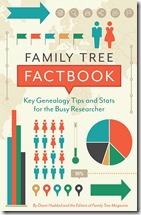 Title: Family Tree Factbook: Key Genealogy Tips and Stats for the Busy Researcher
Title: Family Tree Factbook: Key Genealogy Tips and Stats for the Busy Researcher
Author: Diane Haddad
Format: Paperback
Published: 2018
My Rating: ![]()
![]()
![]()
The following review first appeared in the Federation of Genealogical Societies FORUM magazine (Spring 2020); reprinted with permission.
This post contains affiliate links.
The Family Tree Factbook is intended to be a quick reference guide for US-based genealogy research. There are plenty of facts and tips throughout the book that researchers will find useful.
The opening chapter “Research Basics” includes a glossary of terms, a list of acronyms, and a list of common abbreviations, along with a genealogy records checklist, common myths, examples of writing styles, a primer on crafting source citations, and more. The second chapter relates to the US states, with a handy table of state facts, such as years of statehood, first census, and statewide vital registration. A list of all state archives is also provided in this chapter.
Other chapters include:
- “Libraries and Archives”
- “Names”
- “Genealogy Websites”
- “Computing”
- “Census”
- “Immigration”
- “Military”
- “Cemeteries”
- “Genetic Genealogy”
- “Geography”
- “Social History”
- “Photography”
One appendix contains a variety of helpful worksheets, while the other is a series of blank pages that the reader can use to add their own “facts” in order to keep everything in one place.
There are numerous tables and lists throughout the book. I found the following useful:
- “Nicknames and Variations for Popular Names”
- “Questions in the Census” (All of the census questions for each federal census from 1790 to 1940, which is nice to have all in one place.)
- “State and Territorial Censuses” (A list of all states and what years there was a state-sponsored census.)
- “Timeline of Immigration Laws”
- “Timeline of US Military Conflicts”
- “Major US Migration Routes”
- “Timeline of Disasters”
- “Glossary of Archaic Diseases”
While there is good information compiled in these pages, I’d say most of the content is more “tip” related than facts. It’s great to have the facts in one place, however most experienced genealogists probably have their own similar compilations, or at least know where to look for the information they seek. Similarly, experienced genealogists will likely find themselves frustrated trekking through all of the interspersed tips just to get to the facts. Therefore, I think this book is better suited for a beginner who is looking for quick tips to enhance their genealogy research.

